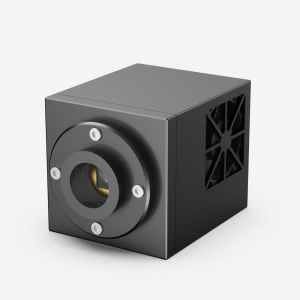
Introduction
Single-photon avalanche diodes (SPADs) are semiconductor detectors operated above breakdown voltage (“Geiger mode”) so that a single photon triggers a self-sustaining avalanche current. In Geiger mode, a single photon absorption generates a macroscopic current pulse with very fast rise time, and the leading edge of that pulse corresponds precisely to the photon’s arrival time. This gives SPADs intrinsic gain on the order of 10^6–10^7 and timing jitter on the order of tens to hundreds of picoseconds. By counting these digital pulses over time, the sensor achieves true photon-counting with high signal‐to‐noise ratio.
Lontenoe’s InGaAs Geiger Avalanche Focal Plane Module integrates a 2D SPAD array for near-infrared (NIR) single-photon imaging. InGaAs/InP SPADs extend sensitivity well into the SWIR band (~0.9–1.7 μm), covering fiber-optic and eye-safe LiDAR wavelengths. InGaAs devices also exhibit lower dark current and noise than germanium and can operate with TEC cooling to reduce dark counts. The NIR response makes them ideal for eye-safe 1550 nm LiDAR, free-space optical communication and night-vision applications. Importantly, InGaAs SPADs excel in the eye-safe 1.4–1.7 μm range where higher laser power can be used without hazard.
How It Works
In the focal plane array, each pixel is a reverse-biased InGaAs SPAD. When a photon is absorbed in the InGaAs layer it generates an electron–hole pair that, under the high electric field, triggers an avalanche of carriers. A quenching circuit (often on-chip) then rapidly reduces the bias to stop the avalanche, producing a standard digital pulse. The output of each pixel is thus a short TTL/LVDS pulse whenever a photon is detected. By scanning or gating the array and time-stamping pulses, the system can form 2D photon-counting images or measure time-of-flight distances with picosecond precision.
Key Features of InGaAs SPAD Focal-Plane Module from Lontenoe
Lontenoe’s Geiger-mode focal plane module (GD6410S/GD12810S) offers the following technical specifications (operating temperature ~–40–0 °C with TEC):
- Array size & pitch: Available in 64×64 or 128×128 pixel formats, with 50 µm pixel spacing. (Each SPAD active area is typically ~25–35 µm within a 50 µm pitch.)
- Spectral range: Optimized for 0.9–1.7 µm NIR, covering standard telecom (1.31/1.55 µm) and eye-safe LiDAR wavelengths.
- Photon Detection Efficiency (PDE): ~20% typical (peak) for NIR photons. The array’s “single-photon detection rate” is specified at ~20% for nominal conditions. (Anti-reflection coatings and microlenses enhance PDE.)
- Dark Count Rate (DCR): Very low in cooled operation. Typical dark count is on the order of 5 kHz per pixel (64×64 array) or 15 kHz (128×128 array), measured at rated PDE. Cooling the InGaAs detectors (e.g. to –40 to 0 °C) greatly suppresses thermal noise.
- Timing resolution: The module can gate each pixel at nanosecond timescales. The minimum gate width is ~2 ns (with programmable duty cycle), and the system time jitter is 0.5 ns for the 64×64 array or as low as 150 ps for the 128×128 version. This supports time-of-flight distance precision on the order of centimeters or better.
- Effective fill factor & crosstalk: The design yields >99% usable pixels (effective pixel rate), with a measured inter-pixel crosstalk probability ≲15%. Guard-ring structures around each SPAD help suppress edge breakdown and optical crosstalk.
- Afterpulsing: Built-in negative-feedback quenching keeps afterpulsing very low (a few percent or less). Lontenoe’s NFAD (negative-feedback avalanche diode) design allows free-running operation with inherently low afterpulse probability. Programmable dead-times (hold-off) further reduce spurious counts.
- Interface/output: Each pixel outputs a standard digital pulse upon photon detection. The module provides real-time TTL or LVDS pulses per pixel, suitable for time-stamping or counting. No external readout is needed for basic photon counting.
- Cooling & power: The module includes an integrated thermoelectric cooler and temperature control (up to ~15 W power) so it can operate at sub-zero temperatures for lowest DCR. The 64×64 unit can run down to –40 °C, while the 128×128 model typically operates to –10 °C.
- Gate timing: Users can program gate width and timing; minimum gate width is ≈0.1 μs with 0.01 μs resolution (via on-board FPGA/logic), and hold-off times from 0.1–2.0 μs are selectable. This allows precise strobing of laser pulses for time-correlated measurements.
In summary, Lontenoe’s module combines a dense InGaAs/InP SPAD array with high PDE and low noise, fast gating (ns resolution), and built-in timing electronics. This yields a turnkey single-photon camera capable of real-time 3D imaging.
Applications
The high sensitivity and timing performance of InGaAs SPAD FPAs enable a range of advanced applications:
- 3D LiDAR and Time-of-Flight imaging: Geiger-mode InGaAs arrays are widely used in next-generation LiDAR. The array’s single-photon sensitivity allows detection of extremely weak return pulses, enabling long-range 3D mapping and imaging even in daylight or obscurants. By measuring photon return times across the array, the system directly forms 3D point clouds. The Lontenoe module’s 1.55 μm eye-safe operation and 2 ns gating make it ideal for autonomous vehicle LiDAR and terrain mapping. Using an array (vs. a single-pixel SPAD) greatly increases pixel throughput and frame rate, supporting up to ~20 kHz frame rates in this design. (Compared to single-detector LiDAR, SPAD arrays enable simultaneous range measurement at many angles, reducing scan time.)
- Quantum optics and optical communication: InGaAs SPADs are crucial for infrared quantum experiments. They are used to detect single photons in fiber-based quantum key distribution (QKD) systems and other secure optical links. The array format can further increase key rates by parallel detection. The 0.9–1.7 μm range covers both telecom fibers and eye-safe free-space wavelengths, making these devices suitable for satellite or deep-space optical communication. High-speed gating (>10 MHz) and very low afterpulsing are essential for free-running QKD detectors. (In fact, Lontenoe recommends pairing the FPA with their high-rate SPAD quenching electronics for quantum-communication applications.)
- Low-light and NIR imaging (aerospace, surveillance, biomedical): The high NIR sensitivity also benefits scientific imaging. For example, InGaAs SPAD cameras can capture low-photon biological fluorescence (time-resolved microscopy/FLIM) or night-time thermal scenes. In defense and aerospace contexts, NIR single-photon cameras allow imaging through haze or from dim starlight. The ability to time-stamp photons also enables advanced techniques like time-gated imaging and fluorescence lifetime imaging. (In short, any scenario requiring photon-starved NIR imaging – from forest surveillance to planetary exploration – can benefit from Geiger-mode InGaAs arrays.)
- Research and metrology: SPAD arrays are used in pulsed LiDAR for robotics and in scientific instruments like confocal microscopes and time-of-flight 3D scanners. The 50 µm pitch and high fill factor of Lontenoe’s array allow fine spatial resolution, and the picosecond timing can support high-speed time-correlated measurements and photon-counting histograms.
Overall, Lontenoe’s InGaAs Geiger-mode FPA excels in any application demanding both near-IR sensitivity and precise time resolution. Its high PDE, low DCR, and built-in gating circuitry give it technical advantages over linear-mode detectors (APDs) in true photon-counting scenarios.
Comparative Analysis of Similar SPAD Arrays
Several other manufacturers offer single-photon detector arrays or modules in the NIR. For example, Princeton Lightwave (USA) produces a 32×32 InGaAs/InP Geiger-mode APD array (100 µm pitch) hybridized to a CMOS ROIC. This array, with an integrated two-stage TEC cooler and GaP microlenses, supports 3D LADAR at 1.06 µm or 1.55 µm (eye-safe). It delivers true single-photon sensitivity and per-pixel time-of-flight readout at frame rates up to ~200 kHz.
In Europe, Micro Photon Devices (MPD) offers a 32×32 “SPC²” camera with 100 µm pixels. Each pixel contains a 20 µm SPAD and electronics in a smart-pixel architecture. The MPD camera (silicon-based) covers the visible–NIR range (~0.4–1.0 µm) and provides low-jitter timing (~100 ps) without active cooling. While MPD’s device is silicon (not InGaAs), it demonstrates the general SPAD-camera concept.
In China, EIPEKS Optoelectronics offers a commercial InGaAs 4×4 SPAD module (100 µm pitch). Its performance (≥10% PDE, ≤10 kHz dark count per pixel, ≤500 ps jitter) is comparable to earlier-generation single-pixel detectors but in a small array format. Like Lontenoe’s module, EIPEKS’s device operates in the 0.95–1.65 µm band.
Hamamatsu (Japan) does not currently sell large-format InGaAs Geiger arrays. They offer InGaAs APD and photoconductive diode arrays (linear mode) as well as silicon SPAD modules (MPPCs), but not an integrated InGaAs FPA for photon counting. This highlights Lontenoe’s niche: delivering a full-featured InGaAs Geiger-mode imaging module that is not available from the largest photonics OEMs.
Comparative Performance
Vendor / Model | Array (pixels) | Pixel Pitch | Photon Detection Efficiency (PDE) | Timing Resolution / Jitter | Cooling | Output / Interface | Spectral Range |
Lontenoe GD6410S(InGaAs FPA) | 64×64 | 50 µm | ~20% (at peak) | 2 ns gate width / 0.5 ns jitter | Integrated TEC (–40 °C) | Digital pulse (TTL/LVDS) | ~0.9–1.7 µm |
Lontenoe GD12810S(InGaAs FPA) | 128×128 | 50 µm | ~20% | 2 ns gate / 150 ps jitter | Integrated TEC (–10 °C) | Digital pulse (TTL/LVDS) | ~0.9–1.7 µm |
Princeton Lightwave 32×32 GmAPD | 32×32 | 100 µm | (high, ~20–30%) | <100 ps (pixel intrinsic) | 2-stage TEC | FPGA / digital 3D output | 1.06 µm or 1.55 µm |
MPD SPC² 32×32 Camera(Si SPAD) | 32×32 | 100 µm | ~50% (Si detector) | ~100 ps (pixel) | Ambient (no TEC) | Digital camera output | 0.4–1.0 µm (Si) |
EIPEKS InGaAs 4×4 Module | 4×4 | 100 µm | ≥10% (at 1.57 µm) | ≤500 ps | Likely TEC | (pixel pulses) | 0.95–1.65 µm |
Each entry highlights the trade-offs. Lontenoe’s modules stand out by offering a relatively large pixel count at modest 50 µm pitch, with built-in cooling and digital outputs. The Princeton device matches the NIR band with high performance but at larger pitch (100 µm) and external FPGA interface. MPD’s camera (silicon) covers visible/NIR at similar pixel density. The Chinese EIPEKS module is small (4×4) and lower PDE but demonstrates the same InGaAs SPAD technology.
Summary
Lontenoe’s InGaAs Geiger-mode SPAD focal plane module combines key technical advantages for NIR photon imaging: a dense 2D array of NFAD pixels, high PDE (~20%), and low DCR thanks to TEC cooling. It offers adjustable ns-scale gating and outputs digital pulses from every pixel. These capabilities make it well-suited to cutting-edge applications like 3D LiDAR, quantum communications, and ultra-low-light imaging. Compared to alternatives, it fills a unique niche by integrating InGaAs single-photon detectors, fast timing, and array-scale readout in one commercial package. In short, Lontenoe’s module delivers high sensitivity and precise timing in the NIR, enabling engineers and researchers to build advanced photon-counting systems without custom sensor development.





